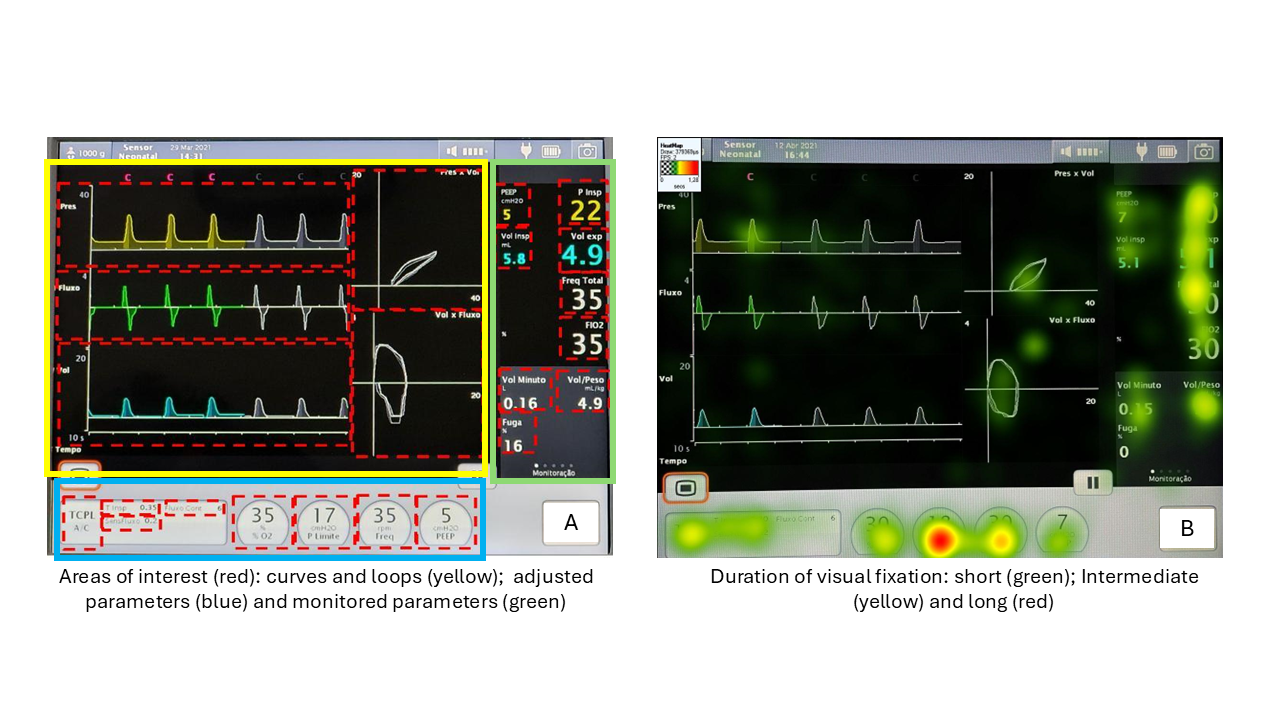Neonatal General 1: Respiratory, BPD
Session: Neonatal General 1: Respiratory, BPD
270 - Eye-tracking in neonatal intensive care: physicians' visual attention when evaluating the monitoring screen of a ventilator
Friday, April 25, 2025
5:30pm - 7:45pm HST
Publication Number: 270.4924
Pamella Cristina. do Prado Franco, Universiadade Federal de São Paulo, Sao Paulo, Sao Paulo, Brazil; Marina CM. Barros, Universidade Federal de Sao Paulo, São Paulo, Sao Paulo, Brazil; ROBERTO GONCALVES DE MAGALHAES. JUNIOR, FEI, São Bernardo do Campo, Sao Paulo, Brazil; Simone Yumi Tsuji. Assuncao, Universidade Federal de Sao Paulo, Guarulhos, Sao Paulo, Brazil; Beatriz Mesquira. mello, Universidade Federal de Sao Paulo, São Paulo, Sao Paulo, Brazil; Ana Silvia Marinonio, Universidade Federal de Sao Paulo, Sao Paulo, Sao Paulo, Brazil; Mandira Daripa Kawakami, Federal University of Sao Paulo, Atibaia, Sao Paulo, Brazil; Milton Miyoshi, Universidade federal de sao paulo, Sao Paulo, Sao Paulo, Brazil; Maria Fernanda de Almeida, Universidade Federal de Sao Paulo, Sao Paulo, Sao Paulo, Brazil; Tatiany Heiderich, FEI, São Paulo, Sao Paulo, Brazil; Rafael Nobre. Orsi, FEI, São Paulo, Sao Paulo, Brazil; Carlos Eduardo Thomaz, FEI, Sao Bernardo do Campo, Sao Paulo, Brazil; Ruth Guinsburg, Universidade Federal de São Paulo, São Paulo, Sao Paulo, Brazil

Ruth Guinsburg, MD, PhD (she/her/hers)
Full Professor of Pediatrics
Universidade Federal de São Paulo
Universidade Federal de São Paulo
São Paulo, Sao Paulo, Brazil
Presenting Author(s)
Background: Investigating the role of human perception, medical data, and support technologies in neonatal intensive care may deepen our understanding of factors guiding medical decisions.
Objective: To verify the physicians' visual attention when evaluating the monitoring screen of a ventilator to decide whether or not to change the ventilatory settings.
Design/Methods: This experimental study involved 45 neonatologists and 30 pediatric/neonatal trainees. Each participant was randomly assigned a clinical case depicting hypoxemia, hypercapnia, or normal blood gases, shown via computer, followed by a 30-second video of the iX5 ventilator™ monitoring screen (Vyaire Medical, USA). Participants’ gaze was tracked using the Tobii TX300 eye tracker (Tobii, Sweden) as they viewed the video. At the end of each video, participants indicated whether they would adjust any ventilator parameter. The tracked areas of interest (AOI) were: monitored parameters, adjusted parameters, and curves/loops (Figure 1A). Outcomes included AOI visual fixation (yes/no), and both the number and duration of visual fixations (seconds). An example of eye tracking capture of one participant is shown in Figure 1B. All participants completed the Beck Anxiety Inventory before viewing the clinical case. The visual tracking outcomes were compared among participants who evaluated the three situations, and between neonatologists vs. trainees by multivariate analysis of variance (MANOVA) adjusted for confounders.
Results: Eye tracking was analyzed over 10 seconds, with ocular signals captured 95 ± 5% of the time. Among all 75 participants, 100% fixated on curves/loops, 95% on monitored parameters, and 80% on adjusted parameters. Number and duration of visual fixation were highest on curves/loops (14.7±7.6 and 3.7±2.1 sec), followed by monitored parameters (8.0±6.0 and 2.1±1.6 sec) and by adjusted parameters (5.4±5.0 and 1.2±1.3 sec). No significant tracking differences emerged by clinical cases (Table 1). However, trainees displayed a higher number and longer duration of fixations on adjusted parameters compared to neonatologists (Table 2).
Conclusion(s): The evaluation of the focus of visual attention during medical decisions may help to understand how these decisions are made and may give useful insights to improve medical training. Observed differences between trainees and neonatologists warrant further examination across different ventilator interfaces.
Table 1. Number and duration of visual fixations on the different areas of interest according to the clinical case presented to the participant
.png)
Table 2. Number and duration of visual fixations on the different areas of interest according to the experience with neonatal critical care
.png)
Figure: Ventilator monitoring screen. A: Areas of interest; B: Example of eye tracking capture of one participant


